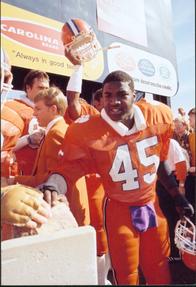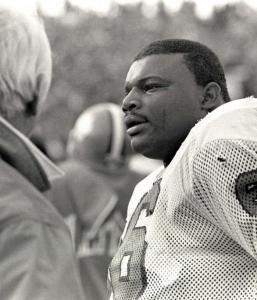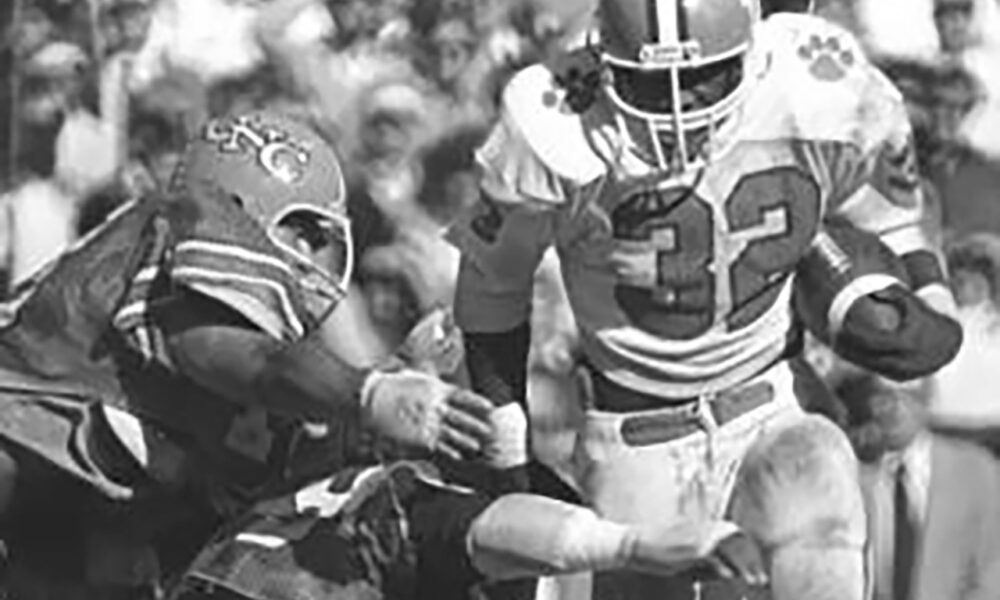Through the years, Clemson and North Carolina have met on the gridiron with a lot riding on the line, especially in the late 1970s and 1980s.
In 1977, with the ACC Championship at stake, the two teams settled for a 13-13 tie. The Tar Heels won the league that year, edging the second place Tigers in the standings.
In 1980, North Carolina defensive end Lawrence Taylor stopped Homer Jordan at the goal line on the last play of the game in Week 9, to preserve a 24-19 Tar Heel victory and an ACC Championship. It is the last time UNC won an ACC Championship in football.
Of course, Clemson had its big moments too. In 1982, the Tigers knocked North Carolina out of the ACC Championship race and went on to win it themselves with a 16-13 victory at Death Valley.
In 1983, Clemson shocked the 10th-ranked Tar Heels, 16-3, in Chapel Hill and prevented them from winning the ACC title. The Tigers, due to NCAA and ACC sanctions, were ineligible to win the ACC crown in 1983, but there was little doubt who the best team in the league was. Clemson finished the year 7-0 in ACC games. The Tigers won 20 straight ACC games from 1981-1984.
The two teams meet again in 1986 and in 1987 with the ACC Championship on the line. The Tigers won both times, including a 13-10 thriller at Chapel Hill in 1987. David Treadwell made a game-winning field in the final minutes to help the Tigers win another ACC Championship.
However, the best game between these two rivals took place in 1981 at Keenan Stadium in Chapel Hill. Arguably, it is still considered the greatest game in ACC history between two league teams.
A second-ranked Clemson team—still playing for a possible national championship—defeated the No. 8 Tar Heels, 10-8.
1981 was “10-8acious”
“10-8acious” was the headline in The Greenville News the next morning, as the Upstate newspaper recognized how physical and how hard both teams played in the epic showdown.
Heading into its much-anticipated game with North Carolina, Clemson was coming off an 82-point performance against Wake Forest the week before. Clemson head coach Danny Ford knew Game 9 of the 1981 season would be the toughest one left on the schedule. He also knew it would be the one with the most distractions.
Clemson, 8-0, was ranked No. 2 by the Associated Press and No. 3 by United Press International (the Coaches Poll) coming into its November 7, 1981 clash at North Carolina. The Tar Heels were 7-1 and ranked No. 8 in both major polls.
“The North Carolina game did more for us winning the national championship than any other game,” said All-American linebacker Jeff Davis. “It was the ultimate test for us. We expected to win in Death Valley, and we expected teams to already be behind when the whistle blew in Death Valley. But to go into the backyard of a top 10-football team with everything at stake, and win, that did it for us.
“Remember, North Carolina had everything to play for. It’s right there for them. You can think there were people wondering ‘Can Clemson stay focused?’ And we beat them in a fight. It was an all-out brawl. May the best man win. It was man-on-man.”
The 1981 contest was the first time in the history of ACC football that two of its schools clashed in a battle of top 10 teams. With an ACC Championship and a major bowl bid at stake, it was dubbed the biggest game to ever be played in the state of North Carolina.
“(North Carolina) came to play,” said defensive end Jeff Bryant. “They were at home and they were a top 10 team. We both were striving for that goal which was to win the ACC and take it further from that.
“It was a very physical game. I can remember being sore for a couple of days after that.”
It was also Homecoming Weekend in Chapel Hill, and it was the last game at Kenan Stadium for UNC’s seniors, a class that had helped the Tar Heels win an ACC Championship the year before and beat traditional powers such as Texas and Oklahoma along the way.
To top things off there were bowl representatives from eight bowl games in attendance, more than any other game that afternoon across the country. Sports Illustrated had been at Clemson all week to chronicle the Tigers’ magical run and was in Chapel Hill on that afternoon as well.
ABC was broadcasting it as part of their regional coverage and carried the game throughout most of the country. All of America’s eyes seem to be placed on this small school from the foothills of South Carolina, and Ford knew he had to do something to turn his team’s focus to what was really important – beating the Tar Heels.
Carolina on my Mind
So, the 33-year old coach put up “Carolina On My Mind” posters on just about every available space in the Jervey Athletic Center that week.
“Were we excited about the hype? Yes. We wanted the stakes high,” said Davis. “It didn’t get better than this. This was another opportunity for us to do something in Clemson football history that had not been done.
“We took all of that into consideration. We would not have approached that game any other way because there was the crown jewel of college football standing right in front of us. We could almost touch it.
“The world was watching. We had a great opportunity. It was everything that a young man and a young student-athlete could want.”

Jeff Davis and the Clemson defense allowed three teams to score more than 10 points in 1981—Wake Forest, South Carolina and Nebraska—and it went 18 quarters without giving up a touchdown during one stretch. (File Photo/Clemson Athletic Communications)
Nobody loved playing North Carolina more than Davis, now an athletic administrator on Dabo Swinney’s staff at Clemson. A native of Greensboro, N.C., he has a distain for the “Powder Blue” like no one else.
“North Carolina, for me, was a big game,” he said. “I’m from North Carolina, and I want to beat them more than anyone else we play. This was my last opportunity to make a statement in North Carolina that I made the right decision in coming to Clemson.”
It also didn’t help that the Tar Heels had taken down Davis and the Tigers the year before in Death Valley. It was the first time he lost to North Carolina and the 223-pound linebacker did not like the taste it left in his mouth.
It also stung because the Tar Heels were clearly the more physical team in 1980, thanks to a future Hall of Famer named Lawrence Taylor, who had sacked Jordan for a nine-yard loss during a goal-line stand to preserve UNC’s 24-19 victory.
“We didn’t like them and they didn’t like us,” Davis said. “We both knew it was going to be a hard-fought physical game. They had some very good athletes and they were a very good football team. We were going into their backyard. It was going to be tough.”
Ford knew it was going to be tough too, and though he didn’t tell his team, he had some doubt whether they could stand up to the Tar Heels’ physicality.
“I was concerned about how we can play physically with this team,” he said. “We were out-muscled in 1980, which did not happen too often with our football teams. Their game plan in 1980 was to out-muscle Clemson, and I think they did it.
“We knew that’s what they were going to try and do again.”
It was physical
Ford was right. North Carolina came out to hurt Clemson. It wanted to be the intimidator. It wanted to be more physical. The Tar Heels did that in some way. They knocked running back Jeff McCall out of the game in the fourth quarter with two broken ribs as well as defensive tackle Dan Benish with a sprained knee.
McCall had a game-high 84 yards before he left and scored the game’s lone touchdown, a seven-yard run with 6:54 to play in the second quarter.
But don’t think North Carolina went untouched. The Tigers removed UNC quarterback Rod Elkins in the second quarter after he led his team on a field goal drive. Elkins had sprained his ankle two weeks before in a loss to South Carolina, and though he did not start the Clemson game, he was soon put in after starter Scott Stankavage was sacked once and fumbled twice on the Tar Heels’ first two drives.
On the very next play from scrimmage following McCall’s touchdown, Elkins re-injured his ankle and did not return. With North Carolina’s best quarterback now out of the game, the Tigers could concentrate more on shutting down The Tar Heels’ potent rushing attack.
UNC ranked second in the country running the football coming in, but Clemson held the Heels to 84 yards on 42 carries. Stopping the run had been the Tigers’ ammo all season. With new defensive coordinator Tom Harper at the helm, Clemson led the ACC in rushing defense and ranked second in the country.
“We would put a goose egg on our (defensive) board before every game,” Davis said. “We didn’t do it as a mark or just to put something up there. No, we actually believed it. It was symbolic to us. You were not going to score on us. Even if you get in our territory, you might have a chance to get a field goal, but you can forget about scoring on us.
“We took pride in that. You were not supposed to score on us. We even took pride in goal line (situations) in practice. I don’t care how close you put the ball you were not going to score on our defense. We believed that. That was not some tough guy talk or something to motivate people. We believed it.”
North Carolina running back Kelvin Bryant believed it. In his first game back after arthroscopic knee surgery five weeks earlier, he gained just 31 yards on 13 carries, as did fellow running back Tyrone Anthony on eight carries.
“When I see Kelvin, he likes to joke that he gets a headache right when he sees me because we were hitting him so hard that day,” Davis smiled.
The Hero
Bill Smith, now on Clemson’s Board of Trustees, is sort of the unsung hero from the 1981 game. The play everyone remembers is Bryant having the presence of mind to jump on what appeared to be an incomplete pass with 57 seconds to play.
The pass was ruled a lateral, and by jumping on the loose football Bryant secured Clemson’s 10-8 victory in front of a then record crowd at Kenan Stadium of 53,611. But what people don’t recall is who actually caused the fumble.
That would be Smith, whose son Cannon played on Clemson’s 2016 and 2018 national championship teams. After moving the ball out from the shadow of their own goal line, the Tar Heels found themselves with a first down at their own 40 thanks to a 12-yard scramble by Stankavage on third-and-10 from the two, then a 9-yard pass to wide receiver Ron Richardson and a 14-yard pass to Anthony.
With just over a minute to play and one timeout left, the Tar Heels called a screen pass to fullback Alex Burrus. Stankavage threw the ball behind the line of scrimmage and when Burrus went to make the catch, Smith met him, knocking the ball to the ground.
The ball rolled 15 yards backwards towards the Clemson sideline, and that is where Bryant jumped on the football at the UNC 25-yardline.
“They were moving the ball down the field, and all they needed was a field goal to win,” Smith said. “That was just a timely play that happened.”
Timely indeed. In fact, it was perhaps the calling-card of the 1981 defense.
In 1981, Clemson ranked seventh in the nation in turnover margin and led the ACC in forced turnovers with what is still a school-record 41.
“That play epitomizes our football team,” Davis said. “We are talking about Bill Smith, a guy when people talk about our national championship team, they don’t think about. Those were the type of players we had that made plays when plays needed to be made. He makes that play and then Jeff Bryant was the only guy on the field that had the sense of mind to know that was a lateral and ‘I’m getting on this thing.’
“That’s the kind of football team we were. We did the little things. We played hard and we tackled hard.”
No team that season learned that any better than the Tar Heels. Twice, North Carolina had first-and-goal inside the Clemson 10, and both times it was held to short field attempts by Brooks Barwick.
Early in the second quarter, North Carolina appeared to have a possible touchdown on a third-down swing pass in the flats to Anthony, but Clemson All-American safety Terry Kinard came out of nowhere to drag him down at the five. The Tar Heels settled for a 22-yard Barwick field goal and led 3-0.
Now Trailing 10-5, following a Donald Igwebuike 39-yard field goal, UNC took its second drive of the third quarter and marched down to the Clemson four thanks to a 21-yard halfback pass from Anthony to Griffin. But Davis and Kinard stuffed Kelvin Bryant for a five-yard loss on the next play and then Stankavage threw incomplete on second and third down, forcing the Tar Heels to settle for a 26-yard Barick field goal.

William Perry, a freshman at the time, had a big 10-yard sack in the fourth quarter in the 1981 game in Chapel Hill, N.C., that prevented North Carolina from kicking a go-ahead field goal. (File photo/Clemson Athletic Communications)
In the fourth quarter, North Carolina again had an opportunity to take the lead following a muffed punt by Billy Davis at the Clemson 37. After gaining just four yards on first and second down, the Tar Heels hopes for taking the lead were dashed when freshman nose guard William Perry broke through and sacked Stankavage for a 10-yard loss.
“With the kind of defense we had, we never panicked,” Bryant said. “We are going to make the big play. It was always role call to the ball.”
Following a Clemson punt, UNC again moved into Tiger territory to the 39, but again the defensive stiffened, with a tackle for loss and two incomplete passes.
Unable to move the ball on the ensuing possession, Clemson punter Dale Hatcher then pinned the Heels deep in their own territory at the two-yard line with 2:19 to play, setting up the final dramatics in one of the biggest victories in Clemson history.
Staying alert
Jeff Bryant, who played 12 seasons in the NFL, had a stellar career at Clemson, but it wasn’t until Tom Harper became the defensive coordinator in the spring of 1981 when he finally realized what kind of player he could be.
Harper did wonders for Bryant’s play. He helped him become sound fundamentally. He helped him with his technique. He helped him become a better football player, and a better person.
“Tom Harper was very instrumental in my development,” Bryant said. “He was a great guy. I wish I had Tom Harper all four years. I’m thankful I had him when I did though because he really made a difference with me.”
Bryant credited Harper’s instruction as one of the reasons he stayed alert and recognized the lateral on North Carolina’s final drive.
“I was coming up field pretty hard because I figured they were going to pass the ball. I had a good rush on, and I was about as deep as the quarterback,” he said. “I noticed him throwing the ball, and I saw the hit, but I noticed he threw the ball behind him.
“Bill made a great hit and I saw the ball coming out, so my thinking was to rush over there and get on it because no one else thought it was a lateral. I thought it was one because of the angle I was at because I was right there behind the quarterback as he threw the ball.”
Smith, who admits he did not know it was a lateral at the time, sometimes wonders about the “what ifs” had Bryant not jumped on the loose ball.
“Who knows what would have happened had we lost that game but thank goodness we can say ‘what if’ all we want because we didn’t lose it,” he said. “We won it and we did all we could do to win it. That was the mentality of that team all year.”
After Homer Jordan fell to the ground three times to run out the final 57 seconds, a mass celebration broke out on the Clemson sideline. As Tar Heel fans made their way to the exits, the Clemson players and the 10,000 or so Tiger fans that traveled up to Chapel Hill, stayed and enjoyed what they had accomplished.
“We knew that anything was possible at that point,” Bryant said.
With a victory over the No. 8 Tar Heels behind them, Clemson for the first time admitted the possibility of going undefeated and playing for a national championship was on their mind.
“It was important because we started thinking a little bit now about being undefeated,” Davis said. “Until that point, we were not trying to touch it. There might have been a few rumblings here and there, but we were all about one game at a time.
“At that point and where we were at, you were going to have to do something phenomenal to beat us.”
And no one did.
We are pleased to announce a new partnership with Fanatics. This is great news for Tiger fans as they have the officially licensed Clemson gear.
The Clemson Insider will get a portion of all sales so get ready for another championship season by ordering your Clemson gear today and help support TCI.


